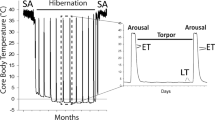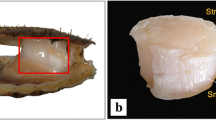Abstract
Hibernating mammals have the remarkable ability to withstand long periods of fasting and reduced activity with dramatic maintenance of skeletal muscle function and protein composition. We investigated several hindlimb muscles of white-tailed prairie dogs (Cynomys leucurus) and black bears (Ursus americanus), two very different hibernators who are dormant and fasting during winter. The black-tailed prairie dog (C. ludovicianus) remains active during winter, but suffers minor skeletal muscle atrophy; nevertheless, they also demonstrate apparent skeletal muscle adaptations. Using SDS-PAGE, we measured myosin protein isoform profiles before and after the hibernation season. All species maintained or increased levels of slow myosin, despite the collective physiological challenges of hypophagia and reduced activity. This contrasts markedly with standard mammalian models of skeletal muscle inactivity and atrophy predicting significant loss of slow myosin. A mechanism for changes in myosin isoforms was investigated using reverse-transcription PCR, following partial sequencing of the adult MHC isoforms in C. leucurus and U. americanus. However, mRNA expression was not well correlated with changes in MHC protein isoforms, and other synthesis and degradation pathways may be involved besides transcriptional control. The muscles of hibernating mammals demonstrate surprising and varied physiological responses to inactivity and atrophy with respect to slow MHC expression.





Similar content being viewed by others
References
Adams GR, Caiozzo VJ, Baldwin KM (2003) Skeletal muscle unweighting: spaceflight and ground-based models. J Appl Physiol 95:2185–2201
Baldwin KM (2001) Plasticity in skeletal, cardiac, and smooth muscle. Invited review: effects of different activity and inactivity paradigms on myosin heavy chain gene expression in striated muscle. J Appl Physiol 90:345–357
Baldwin KM, Haddad F (2001) Effects of different activity and inactivity paradigms on myosin heavy chain gene expression in striated muscle. J Appl Physiol 90(1):345–357
Barboza PS, Farley SD, Robins CT (1997) Whole-body urea cycling and protein turnover during hyperphagia and dormancy in growing bears (U. americanus and U. arctos). Can J Zool 75:2129–2136
Caiozzo VJ (2002) Plasticity of skeletal muscle phenotype: mechanical consequences. Muscle Nerve 26:740–768
di Maso NA, Haddad F, Zeng M, McCue SA, Baldwin KM. (2000) Role of denervation in modulating IIb MHC gene expression in response to T(3) plus unloading state. J Appl Physiol 88(2):682–689
Folk GE Jr (1967) Physiological observations of subarctic bears under winter den conditions. In: Fisher KC, Dawe AR, Lyman CP, Schonbaum E, South FE (eds) Mammal hibernation III. American Elsevier Publishing Company, Inc., New York, pp 75–85
Geiser F (1998) Evolution of daily torpor and hibernation in birds and mammals: importance of body size. Clin Exp Pharmacol Physiol 25:736–739
Giger JM, Haddad F, Qin AX, Zeng M, Baldwin KM (2005) Effect of unloading on type I myosin heavy chain gene regulation in rat soleus muscle. J Appl Physiol 98:1185–1194
Glass DJ (2003) Signaling pathways that mediate skeletal muscle hypertrophy and atrophy. Nat Cell Biol 5:87–90
Haddad F, Roy RR, Zhong H, Edgerton VR, Baldwin KM (2003) Atrophy responses to muscle inactivity. II. Molecular markers of protein deficits. J Appl Physiol 95:791–802
Harlow HJ, Menkens GE (1985) A comparison of hibernation in the black-tailed prairie dog, white-tailed prairie dog, and Wyoming ground squirrel. Can J Zool 64:793–796
Harlow HJ (1997) Winter body fat, food consumption and nonshivering thermogenesis of representative spontaneous and facultative hibernators: the white-tailed prairie dog and black-tailed prairie dog. J Ther Biol 22:21–30
Harlow HJ, Lohuis Td, Beck TD, Iaizzo PA (2001) Muscle strength in overwintering bears. Nature 409:997
Harlow HJ, Lohuis T, Anderson-Sprecher RC, Beck TDI (2004) Body surface temperature profiles of hibernating black bears may be related to periodic muscle activity. J Mamm 85:414–419
Hittel D, Storey KB (2002) The translation state of differentially expressed mRNAs in the hibernating 13-lined ground squirrel (Spermophilus tridecemlineatus). Arch Biochem Biophys 401:244–254
Huey KA, Haddad F, Qin AX, Baldwin KM (2003) Transcriptional regulation of the type I myosin heavy chain gene in denervated rat soleus. Am J Physiol Cell Physiol 284:C738–C748
Koebel DA, Miers PG, Nelson RA, Steffen JM (1991) Biochemical changes in skeletal muscles of denning bears (Ursus americanus). Comp Biochem Physiol B 100:377–380
Kumar S, Tamura K, Nei M (2004) MEGA3: integrated software for molecular evolutionary genetics analysis and sequence alignment. Briefings Bioinform 5:150–163
Le Maho Y, Van Kha HV, Koubi H, Dewasmes G, Giraard J, Ferre P, Cagnard M (1981) Body composition, energy expenditure, and plasma metabolites in long-term fasting geese. Am J Physiol 241:1059–1062
Lohuis TD and Harlow HJ (2006) Hibernating black bears are in skeletal muscle protein balance over 110 days of Winter anorexia and inactivity (in review)
McCall GE, Allen DL, Haddad F, Baldwin KM (2003) Transcriptional regulation of IGF-I expression in skeletal muscle. Am J Physiol Cell Physiol 285:C831–C839
McCullagh KJ, Calabria E, Pallafacchina G, Ciciliot S, Serrano AL, Argentini C, Kalhovde JM, Lomo T, Schiaffino S (2004) NFAT is a nerve activity sensor in skeletal muscle and controls activity-dependent myosin switching. Proc Natl Acad Sci USA 101:10590–10595
Nedergaard J, Cannon B (1990) Mammalian hibernation (discussion 685–666). Philos Trans R Soc Lond B Biol Sci 326:669–685
Nelson RA (1973) Winter sleep in the black bear. A physiologic and metabolic marvel. Mayo Clin Proc 48:733–737
Nelson RA, Jones JD, Wahner HW, McGill DB, Code CF (1975) Nitrogen metabolism in bears: urea metabolism in summer starvation and in winter sleep and role of urinary bladder in water and nitrogen conservation. Mayo Clin Proc 50:141–146
Parsons SA, Millay DP, Wilkins BJ, Bueno OF, Tsika GL, Neilson JR, Liberatore CM, Yutzey KE, Crabtree GR, Tsika RW, Molkentin JD (2004) Genetic loss of calcineurin blocks mechanical overload-induced skeletal muscle fiber type switching but not hypertrophy. J Biol Chem 279:26192–26200
Reid WD, Ng A, Wilton R, Milsom WK (1995) Characteristics of diaphragm muscle fibre types in hibernating squirrels. Respir Physiol 101:301–309
Rourke BC, Yokoyama Y, Milsom WK, Caiozzo VJ (2004a) Myosin isoform expression and MAFbx mRNA levels in Hibernating golden-mantled ground squirrels (Spermophilus lateralis). Physiol Biochem Zool 77:582–593
Rourke BC, Qin A, Haddad F, Baldwin KM, Caiozzo VJ (2004b) Cloning and sequencing of myosin heavy chain isoform cDNAs in golden-mantled ground squirrels: effects of hibernation on mRNA expression. J Appl Physiol 97:1985–1991
Spangenburg EE, Booth FW (2003) Molecular regulation of individual skeletal muscle fibre types. Acta Physiol Scand 178:413–424
Steffen JM, Koebel DA, Musacchia XJ, Milsom WK (1991) Morphometric and metabolic indices of disuse in muscles of hibernating ground squirrels. Comp Biochem Physiol B 99:815–819
Talmadge RJ, Roy RR (1993) Electrophoretic separation of rat skeletal muscle myosin heavy-chain isoforms. J Appl Physiol 75:2337–2340
Talmadge RJ, Otis JS, Rittler MR, Garcia ND, Spencer SR, Lees SJ, Naya FJ (2004) Calcineurin activation influences muscle phenotype in a muscle-specific fashion. BMC Cell Biol 5:28
Thomason DB, Herrick RE, Surdyka D, Baldwin KM (1987) Time course of soleus muscle myosin expression during hindlimb suspension and recovery. J Appl Physiol 63:130–137
Tidball JG (2005) Mechanical signal transduction in skeletal muscle growth and adaptation. J Appl Physiol 98:1900–1908
Tinker DB, Harlow HJ, Beck TD (1998) Protein use and muscle-fiber changes in free-ranging, hibernating black bears. Physiol Zool 71:414–424
van Breukelen F, Martin SL (2002) Reversible depression of transcription during hibernation. J Comp Physiol [B] 172:355–361
van Breukelen F, Sonenberg N, Martin SL (2004) Seasonal and state-dependent changes of eIF4E and 4E-BP1 during mammalian hibernation: implications for the control of translation during torpor. Am J Physiol Regul Integr Comp Physiol 287:R349–353
Vyskocil F, Gutmann E (1977) Contractile and histochemical properties of skeletal muscles in hibernating and awake golden hamsters. J Comp Physiol 122:355–361
Wickler SJ, Horwitz BA, Kott KS (1987) Muscle function in hibernating hamsters a natural analog to bed rest? J Therm Biol 12:163–166
Wickler SJ, Hoyt DF, van Breukelen F (1991) Disuse atrophy in the hibernating golden-mantled ground squirrel, Spermophilus lateralis. Am J Physiol 261:R1214–R1217
Wright C, Haddad F, Qin AX, Baldwin KM (1997) Analysis of myosin heavy chain mRNA expression by RT-PCR. J Appl Physiol 83:1389–1396
Wu YZ, Baker MJ, Crumley RL, Caiozzo VJ (2000) Single-fiber myosin heavy-chain isoform composition of rodent laryngeal muscle: modulation by thyroid hormone. Arch Otolaryngol Head Neck Surg 126:874–880
Wu YZ, Crumley RL, Caiozzo VJ (2000) Are hybrid fibers a common motif of canine laryngeal muscles? Single-fiber analyses of myosin heavy-chain isoform composition. Arch Otolaryngol Head Neck Surg 126:865–873
Yacoe ME (1983) Protein metabolism in the pectoralis muscle and liver of hibernating bats, Eptesicus fuscus. J Comp Physiol 15:137–144
Acknowledgments
Funding for this study was provided by the National Institute of Arthritis and Musculoskeletal and Skin Diseases (NIAMS) Postdoctoral Fellowship AR-47749 (BCR), NIH MBRS SCORE 2 S06 GM063119 (BCR), NIH RISE (BCR), NIAMS Grant AR-46856 (VJC), and the National Science Foundation (HJH). Technical assistance was provided by Samira Kasravi, Sarah Christy, Lourdes Pineda, and Laura Magaña; Michael Baker is gratefully acknowledged for help with the immunoblots. All experiments comply with the current laws of the United States.
Author information
Authors and Affiliations
Corresponding author
Additional information
Communicated by H.V. Carey
Rights and permissions
About this article
Cite this article
Rourke, B.C., Cotton, C.J., Harlow, H.J. et al. Maintenance of slow type I myosin protein and mRNA expression in overwintering prairie dogs (Cynomys leucurus and ludovicianus) and black bears (Ursus americanus). J Comp Physiol B 176, 709–720 (2006). https://doi.org/10.1007/s00360-006-0093-8
Received:
Revised:
Accepted:
Published:
Issue Date:
DOI: https://doi.org/10.1007/s00360-006-0093-8




